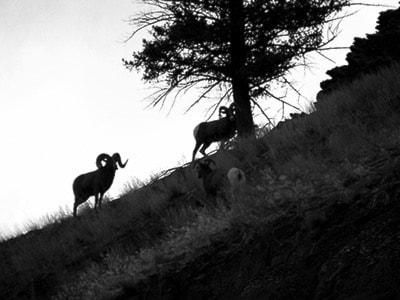The near decimation of the Chasm bighorn sheep herd is part of a troubling century-old trend in North America of wild sheep dying off after coming in contact with domestic sheep.
A town-hall meeting was held in Clinton on Feb. 7 to discuss this local issue, and the broader one of keeping wild and domestic sheep separated to stop the spread of pathogens carried by domestic sheep that are deadly when transmitted to wild sheep.
Jesse Zeman, representing the British Columbia Wildlife Federation, facilitated the meeting, which saw some 50 people in attendance.
“These bighorn sheep are kind of a symbol of nature. They're a pretty important mega fauna in British Columbia and we really need to start to move forward to more sustainable farming practices to ensure the future of big horn sheep.”
The Chasm sheep population declined from more than 110 in the fall of 2013 to about 30 today, according to the Wild Sheep Society of BC.
Four samples were taken recently and two of the sheep tested positive for the antibodies related to pathogens carried by domestic sheep. A ram that tested positive was subsequently culled.
Also troubling is the fact there are other wild sheep populations located west and east of the Chasm herd, so the situation could be more devastating if the pathogens continue to spread to those herds.
It's a frustrating issue for all parties involved and more action is needed from stakeholders, Zeman says, which includes ranchers, farmers, government and conservation groups.
“We need to start working collaboratively and open up a process to make sure there's sheep farming in B.C., but that also wild sheep are protected. It's doable. We just need to sit down and everyone needs to pitch in.”
A bighorn sheep die-off happened around 1999 in the South Okanagan. Some 67 per cent of the herd – 450 down to 150 sheep – died after pneumonia spread through the population. The event spawned the formation of the B.C. Sheep Separation Program (BCSSP), a collaborative program between government agencies, sheep producers, and non-government organizations that work with owners of large domestic sheep farms to keep the two species separated.
Jeremy Ayotte, a representative of the BCSSP, was one of the experts to speak at the meeting in Clinton.
“There's really no parallel issue like this in wildlife.”
To save the Chasm herd the first step is reducing the likelihood of continued exposure, Ayotte notes. However, building fences on private property is more complicated than it sounds, he says, adding fences are not 100 per cent effective either.
“Fences fall down. Trees fall on fences. There's the question of whether or not those wild sheep will still come and nuzzle noses with those domestic sheep. It's definitely an improvement ... you can't deny that, but it's not the [only] solution.”
Local ownership of the problem is one of the answers though, Ayotte says, adding it's great to have the Clinton Rod and Gun Club on board.
The club offered to do land surveys in the area to help gather more information on the herd.
“I think those town-hall meetings are a great step towards that.”
Tamara Giles, a guide-outfitter in the Clinton area, has a Facebook page dedicated to the issue. Giles is concerned the remaining Chasm sheep will be culled.
She attended the meeting to learn more, but in her view, there were no concrete plans expressed about the future of the herd.
“It was such a generic meeting. I don't know if we're on the same page or not, but I hope so.”
Zeman says he wasn't sure about the future of the Chasm sheep because the domestic sheep are still in the area.
“In terms of that specific herd, if we were able to work with that domestic issue first, we would probably try to catch as many of the wild herd and test them, and have to destroy the ones that tested positive to start from scratch.
“The message moving forward is we need to ensure we're farming responsibly and sustainably and have both wild sheep and domestic sheep in British Columbia.”
